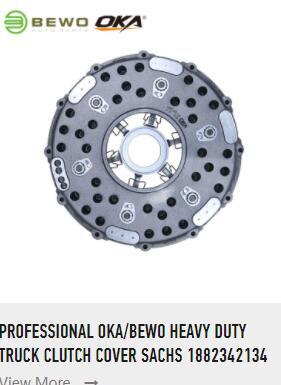Truck Clutch Pressure Plate Replacement Steps
Posted By Ben Woo
Body
The clutch cover assembly is one of the components of the clutch assembly. It is mainly composed of rivets, transmission sheets, moisture-proof rivets, support springs, pressure plates, pressure plate covers, diaphragm springs, and other components. Under normal circumstances, the clutch does not need to be replaced and disassembled, but when it is damaged, it has to be considered.
Replacing the decomposition method:
- Make marks on the truck clutch and truck pressure plate, compress the pressure plate spring with a pressure tool, remove the sharing bracket bolts, release the pressure, and remove the truck clutch cover, pressure plate spring, and heat insulation washer.
- Remove the split pin, punch out the needle bearing pin of the separation rod, and take out the separation rod and needle bearing.
- Punch out the bracket pin of the separation rod, and take out the bracket and the roller. Clean all accessories with kerosene or diesel oil (the friction plate of the driven disc shall not be cleaned with oil), and place them neatly for inspection. Replacement assembly and adjustment method:
- The spare parts should be thoroughly cleaned before assembly (the clutch friction plate does not need to be cleaned).
- Assemble in the reverse order of replacement and disassembly.
- Lubricate all moving parts.
- The plane determined by the three ends of the separation rod should be parallel to the working plane of the pressure plate, and the error should not be greater than 0.4mm, which can be adjusted by the adjustment screw at the inner end of the separation rod. Adjust the distance from the surface of the screw head to the working surface of the flywheel, which should be 51 plus or minus 0.75mm (that is, the inner plane distance of the pressure plate is 41.75-43.25mm). After adjusting the separation rod, the displacement in the direction of the pressure plate should not exceed 1.5mm. . Lock the screw after adjustment.
- The contact plane between the separating thrust bearing and the inside of the separating rod is adjusted by the adjusting screw at the inner end of the separating rod, and the plane error of the three screws should not be greater than 0.4mm.
- Adjustment of the free travel of the clutch pedal. The free stroke is determined by the clearance between the clutch release bearing and the release rod and the clearance between the master cylinder pushrod and the piston. The standard free stroke of the pedal is 32mm.
- The gap between the pushrod of the master cylinder and the piston is 0.5-1.0mm, and the reflection on the pedal is 3-6mm. It can be adjusted by moving the position of the tie rod through the pedal eccentric bolt and then locking the nut after adjustment.
- The gap between the top of the separation rod and the end face of the separation bearing is 2.5-3.5mm, and the reflection on the pedal is 35-45mm, which can be adjusted by changing the length of the pushrod of the working sub-pump. After adjustment, the nut should be tightened.
- When the pedal is fully depressed, the stroke of the push rod of the working cylinder should not be less than 19mm. When the stroke is too small, the clutch cannot be completely disengaged. After the free stroke of the pedal is adjusted, if the stroke is less than 19mm, it may be due to improper operation when adding brake fluid, and air has entered the hydraulic system, which shortens the stroke of the working cylinder pushrod. When venting the air, the oil reservoir should be filled with brake fluid, and then the screw plug should be tightened. The vent plug is used to connect the air pump, and then use the air pump to apply small pressure to the brake fluid; in order to remove the air in the liquid, the air release valve cover at the end of the air release valve must be removed, and a hose must be installed Enter the deflation, one end of the hose should be placed vertically until there is a little air bubble (the air has been exhausted). Then tighten the air valve air release screw, remove the hose from the air release valve cover, and put on the rubber cover. Then inject brake fluid into the oil storage chamber, so that the height of the fluid level is 15-20mm lower than the upper edge of the fuel filler opening. When it is about a cup, stop deflating. After filling the brake fluid, you can continue to deflate. After the adjustment, you should step on the pedal and measure the stroke of the pushrod. When the value is small, the clutch system is normal, and you can continue to deflate until it is discharged.
Taizhou Benwo Auto Parts Co., Ltd. A Clutch Cover Manufacturer and Release Bearing Manufacturer from China. The company's main business is Heavy Duty Truck Clutch, providing Truck Pressure Plate, Truck Clutch Disc, and other clutch components.










Comments